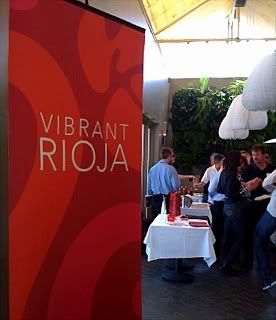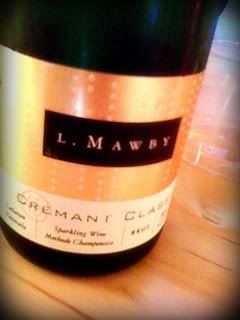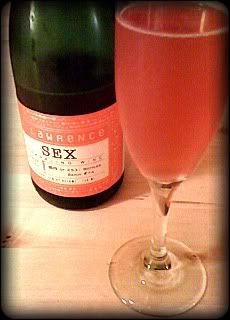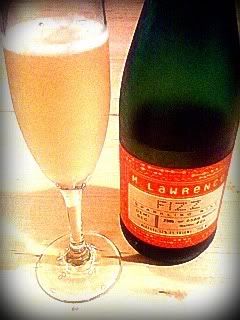It was a Spanish wine tasting event that really got me started exploring wine years ago, and I am repeatedly drawn back to events which feature Spanish wines. The Vibrant Rioja tasting event of April 11, 2011 jumped onto my calendar instantly. It was held at Hatfield's Restaurant in Los Angeles.
The room was perhaps a little small for the gathering of 20 or so importers, all pouring a number of wines at their tables. Space was extremely limited and enthusiastic wine dealers, sommeliers and writers jammed the dining area for the afternoon event.
Great wines abounded, and I'll cover some of them in another post. Today I want to concentrate on my favorite table of the event, the one that was so crowded the whole afternoon I could hardly edge myself in for a few tastes. That would be the table where the wines of Lopez de Heredia were poured.
Lopez de Heredia was founded in 1877 and is a Rioja institution, still owned and operated by the same family. They are particularly proud of their Tondonia Vineyard on the right bank of Ebro River, around which the Rioja region is drawn. Heredia also has three other vineyards, also in Rioja Alta - Cubillo, Bosconia and Zaconia.
The winery is known as much for white wines as for red, maybe more so. They age their whites and rosés in much the same manner the reds are aged, and they stand as a testament to age-worthy whites. White, pink or red, this is what old-world wine is all about.
Heredia's Viña Gravonia 2000 Crianza is a white wine made from 100% Viura grapes. This golden treat is tasting great, with a smokey and nutty taste. It's nice and dry with great acidity.
Viña Tondonia Rosado Gran Reserva 2000 - This brownish peach-colored rosé is a blend of 60% Garnacha, 30% Tempranillo and 10% Viura. The unusual, smokey nose leads to a palate decorated with a nutty strawberry flavor.
Viña Cubillo Crianza 2005 - A red blend of 65% Tempranillo, 25% Garnacha and some Graciano and Mazuelo filling out the rest, this wine offers a hint of anise on the nose and rustic, earthy cherry flavors.
Viña Bosconia Reserva 2002 - Smooth, dusty cherry aromas and flavors dominate this blend of 80% Tempranillo, 15% Garnacha and Graciano and Mazuelo. It's aged in French oak for five years.
Viña Tondonia Tinto Gran Reserva 1991 - Heredia says 1991 was one of the best vintages in the history of the Tondonia Vineyard, and this wine bears out that claim. Toasted vanilla notes and a full mouthfeel are featured in this very dry Tempranillo/Garnacha blend filled out with Graciano and Mazuelo grapes. Aged in barrels for nine years, this wine is old-world elegance defined.
Viña Ijalba Graciano 2007 - Amanda Linn of WineWise was also pouring this new-world style, almost as an afterthought. Its extreme fruitiness was delicious and served as an excellent counterpoint to the Heredia old-world style.
The room was perhaps a little small for the gathering of 20 or so importers, all pouring a number of wines at their tables. Space was extremely limited and enthusiastic wine dealers, sommeliers and writers jammed the dining area for the afternoon event.
Great wines abounded, and I'll cover some of them in another post. Today I want to concentrate on my favorite table of the event, the one that was so crowded the whole afternoon I could hardly edge myself in for a few tastes. That would be the table where the wines of Lopez de Heredia were poured.
Lopez de Heredia was founded in 1877 and is a Rioja institution, still owned and operated by the same family. They are particularly proud of their Tondonia Vineyard on the right bank of Ebro River, around which the Rioja region is drawn. Heredia also has three other vineyards, also in Rioja Alta - Cubillo, Bosconia and Zaconia.
The winery is known as much for white wines as for red, maybe more so. They age their whites and rosés in much the same manner the reds are aged, and they stand as a testament to age-worthy whites. White, pink or red, this is what old-world wine is all about.
Heredia's Viña Gravonia 2000 Crianza is a white wine made from 100% Viura grapes. This golden treat is tasting great, with a smokey and nutty taste. It's nice and dry with great acidity.
Viña Tondonia Rosado Gran Reserva 2000 - This brownish peach-colored rosé is a blend of 60% Garnacha, 30% Tempranillo and 10% Viura. The unusual, smokey nose leads to a palate decorated with a nutty strawberry flavor.
Viña Cubillo Crianza 2005 - A red blend of 65% Tempranillo, 25% Garnacha and some Graciano and Mazuelo filling out the rest, this wine offers a hint of anise on the nose and rustic, earthy cherry flavors.
Viña Bosconia Reserva 2002 - Smooth, dusty cherry aromas and flavors dominate this blend of 80% Tempranillo, 15% Garnacha and Graciano and Mazuelo. It's aged in French oak for five years.
Viña Tondonia Tinto Gran Reserva 1991 - Heredia says 1991 was one of the best vintages in the history of the Tondonia Vineyard, and this wine bears out that claim. Toasted vanilla notes and a full mouthfeel are featured in this very dry Tempranillo/Garnacha blend filled out with Graciano and Mazuelo grapes. Aged in barrels for nine years, this wine is old-world elegance defined.
Viña Ijalba Graciano 2007 - Amanda Linn of WineWise was also pouring this new-world style, almost as an afterthought. Its extreme fruitiness was delicious and served as an excellent counterpoint to the Heredia old-world style.






 A couple of tasty food samples were provided along with the wines. Arancini - Italian rice balls - were provided to those tasting. They paired beautifully with the Viognier, and when adorned with the duck Bolognese sauce, went well with the Sangiovese. Executive Chef Greg Stillman and Sous Chef Vincent Logan (pictured) are to be commended for turning out a large quantity at high quality. Logan told me early Saturday afternoon, "We did 800 of the Arancini, and we're running out. So Greg's in the kitchen working on another batch."
A couple of tasty food samples were provided along with the wines. Arancini - Italian rice balls - were provided to those tasting. They paired beautifully with the Viognier, and when adorned with the duck Bolognese sauce, went well with the Sangiovese. Executive Chef Greg Stillman and Sous Chef Vincent Logan (pictured) are to be commended for turning out a large quantity at high quality. Logan told me early Saturday afternoon, "We did 800 of the Arancini, and we're running out. So Greg's in the kitchen working on another batch."


 The L. Mawby Cremant Classic is made from 100% Leelanau Peninsula Vignoles from the Cremant Vineyard. It's an impressive wine, with frothy white bubbles, sweet citrus notes and almonds on the nose, lots of nuts in the flavor profile and a pleasant lemony feel on the palate. It shows a very pleasant sensation of ginger beer on the finish. The grapes used in making this wine - and the other three I'll mention - are hand-harvested and whole cluster pressed. Only the cuvée - the initial, gently pressed juice - is used in making the Cremant Classic. It retails for $22.
The L. Mawby Cremant Classic is made from 100% Leelanau Peninsula Vignoles from the Cremant Vineyard. It's an impressive wine, with frothy white bubbles, sweet citrus notes and almonds on the nose, lots of nuts in the flavor profile and a pleasant lemony feel on the palate. It shows a very pleasant sensation of ginger beer on the finish. The grapes used in making this wine - and the other three I'll mention - are hand-harvested and whole cluster pressed. Only the cuvée - the initial, gently pressed juice - is used in making the Cremant Classic. It retails for $22. L. Mawby Blanc de Blancs - like the Cremant Classic - is also produced in the méthode champenoise. It's a non-vintage sparkler of 100% Chardonnay from the Leelanau Peninsula AVA. Only the cuvée is used and it is bottle fermented and aged a minimum of 24 months. This wine sports a nutty nose with lemon-lime citrus notes and a yeasty feel on both the nose and palate. It's bright and festive, and retails for $19.
L. Mawby Blanc de Blancs - like the Cremant Classic - is also produced in the méthode champenoise. It's a non-vintage sparkler of 100% Chardonnay from the Leelanau Peninsula AVA. Only the cuvée is used and it is bottle fermented and aged a minimum of 24 months. This wine sports a nutty nose with lemon-lime citrus notes and a yeasty feel on both the nose and palate. It's bright and festive, and retails for $19. The M. Lawrence Sex is a rosé bubbly made from 75% Pinot Noir and 25% Chardonnay grapes. This one is a tad sweeter, getting a Brut dosage of 1.4% RS. Again, only the cuvée is used, but this wine is produced using cuve closefermentation - receiving its second fermentation in a closed tank.
The M. Lawrence Sex is a rosé bubbly made from 75% Pinot Noir and 25% Chardonnay grapes. This one is a tad sweeter, getting a Brut dosage of 1.4% RS. Again, only the cuvée is used, but this wine is produced using cuve closefermentation - receiving its second fermentation in a closed tank. Fizz is also under the M. Lawrence label, and it's their sweetest sparkling wine. Produced from 75% Pinot Noir and 25% Chardonnay grapes, Fizz differs from the other three L. Mawby wines I tasted, in that the tailles juice is used - the second fraction of juice pressed, after cuvée - and it's finished with a Demi-Sec dosage, 3.5% RS.
Fizz is also under the M. Lawrence label, and it's their sweetest sparkling wine. Produced from 75% Pinot Noir and 25% Chardonnay grapes, Fizz differs from the other three L. Mawby wines I tasted, in that the tailles juice is used - the second fraction of juice pressed, after cuvée - and it's finished with a Demi-Sec dosage, 3.5% RS.

 The 1200 growers in Toro produce wines which have a much darker fruit expression in than those found in in Rioja. Most of the wines tasted at this seminar were between 14% and 15.5% in alcohol content. Toro has whites made from Verdejo and Malvasia. Garnacha is also employed here, but the reds are all about Tinta de Toro, and this tasting was all about the reds.
The 1200 growers in Toro produce wines which have a much darker fruit expression in than those found in in Rioja. Most of the wines tasted at this seminar were between 14% and 15.5% in alcohol content. Toro has whites made from Verdejo and Malvasia. Garnacha is also employed here, but the reds are all about Tinta de Toro, and this tasting was all about the reds. The Wines:
The Wines:


 Biltmore Reserve Chardonnay 2009 North Carolina
Biltmore Reserve Chardonnay 2009 North Carolina Biltmore Estate Château Reserve Blanc de Blancs 2008 North Carolina Méthode Champenoise Brut
Biltmore Estate Château Reserve Blanc de Blancs 2008 North Carolina Méthode Champenoise Brut



 Cabernet Sauvignon Reserve 2007 Napa Valley
Cabernet Sauvignon Reserve 2007 Napa Valley Sauvignon Blanc 2009 Napa Valley
Sauvignon Blanc 2009 Napa Valley